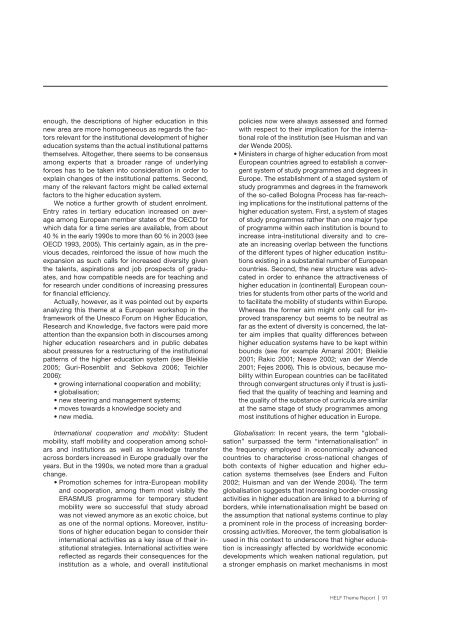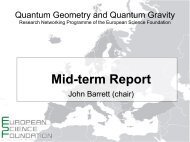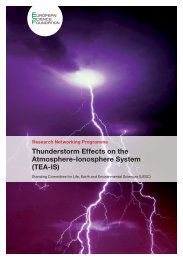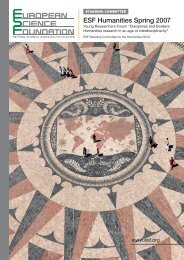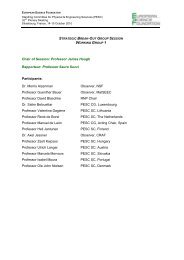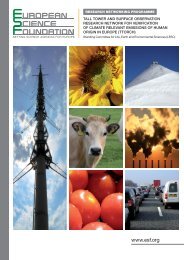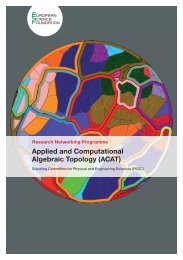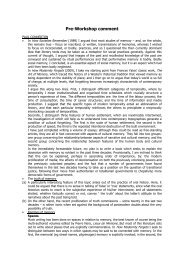Report - European Science Foundation
Report - European Science Foundation
Report - European Science Foundation
Create successful ePaper yourself
Turn your PDF publications into a flip-book with our unique Google optimized e-Paper software.
enough, the descriptions of higher education in this<br />
new area are more homogeneous as regards the factors<br />
relevant for the institutional development of higher<br />
education systems than the actual institutional patterns<br />
themselves. Altogether, there seems to be consensus<br />
among experts that a broader range of underlying<br />
forces has to be taken into consideration in order to<br />
explain changes of the institutional patterns. Second,<br />
many of the relevant factors might be called external<br />
factors to the higher education system.<br />
We notice a further growth of student enrolment.<br />
Entry rates in tertiary education increased on average<br />
among <strong>European</strong> member states of the OECD for<br />
which data for a time series are available, from about<br />
40 % in the early 1990s to more than 60 % in 2003 (see<br />
OECD 1993, 2005). This certainly again, as in the previous<br />
decades, reinforced the issue of how much the<br />
expansion as such calls for increased diversity given<br />
the talents, aspirations and job prospects of graduates,<br />
and how compatible needs are for teaching and<br />
for research under conditions of increasing pressures<br />
for financial efficiency.<br />
Actually, however, as it was pointed out by experts<br />
analyzing this theme at a <strong>European</strong> work shop in the<br />
framework of the Unesco Forum on Higher Education,<br />
Research and Knowledge, five factors were paid more<br />
attention than the expansion both in discourses among<br />
higher edu cation researchers and in public debates<br />
about pressures for a restructuring of the institutional<br />
patterns of the higher education system (see Bleiklie<br />
2005; Guri-Rosenblit and Sebkova 2006; Teichler<br />
2006):<br />
• growing international cooperation and mobility;<br />
• globalisation;<br />
• new steering and management systems;<br />
• moves towards a knowledge society and<br />
• new media.<br />
International cooperation and mobility: Student<br />
mobility, staff mobility and cooperation among scholars<br />
and institutions as well as knowledge transfer<br />
across borders increased in Europe gradually over the<br />
years. But in the 1990s, we noted more than a gradual<br />
change.<br />
• Promotion schemes for intra-<strong>European</strong> mobility<br />
and cooperation, among them most visibly the<br />
ERASMUS programme for temporary student<br />
mobility were so successful that study abroad<br />
was not viewed anymore as an exotic choice, but<br />
as one of the normal options. Moreover, institutions<br />
of higher education began to consider their<br />
international activities as a key issue of their institutional<br />
strategies. International activities were<br />
reflected as regards their consequences for the<br />
institution as a whole, and overall institutional<br />
policies now were always assessed and formed<br />
with respect to their implication for the international<br />
role of the institution (see Huisman and van<br />
der Wende 2005).<br />
• Ministers in charge of higher education from most<br />
<strong>European</strong> countries agreed to establish a convergent<br />
system of study programmes and degrees in<br />
Europe. The establishment of a staged system of<br />
study programmes and degrees in the framework<br />
of the so-called Bologna Process has far-reaching<br />
implications for the institutional pat terns of the<br />
higher education system. First, a system of stages<br />
of study programmes rather than one major type<br />
of programme within each institution is bound to<br />
increase intra-institutional diversity and to create<br />
an increasing overlap between the functions<br />
of the different types of higher education institutions<br />
existing in a substantial number of <strong>European</strong><br />
countries. Second, the new structure was advocated<br />
in order to enhance the attractiveness of<br />
higher education in (continental) <strong>European</strong> countries<br />
for students from other parts of the world and<br />
to facilitate the mobility of students within Europe.<br />
Whereas the former aim might only call for improved<br />
transparency but seems to be neutral as<br />
far as the extent of diversity is concerned, the latter<br />
aim implies that quality differences between<br />
higher education systems have to be kept within<br />
bounds (see for example Amaral 2001; Bleiklie<br />
2001; Rakic 2001; Neave 2002; van der Wende<br />
2001; Fejes 2006). This is obvious, because mobility<br />
within <strong>European</strong> countries can be facilitated<br />
through convergent structures only if trust is justified<br />
that the quality of teaching and learning and<br />
the quality of the substance of curricula are similar<br />
at the same stage of study programmes among<br />
most institutions of higher education in Europe.<br />
Globalisation: In recent years, the term “globalisation”<br />
surpassed the term “internationalisa tion” in<br />
the frequency employed in economically advanced<br />
countries to characterise cross-national changes of<br />
both contexts of higher education and higher education<br />
systems them selves (see Enders and Fulton<br />
2002; Huisman and van der Wende 2004). The term<br />
globalisa tion suggests that increasing border-crossing<br />
activities in higher education are linked to a blurring of<br />
borders, while internationalisation might be based on<br />
the assumption that national systems continue to play<br />
a prominent role in the process of increasing bordercrossing<br />
activities. Moreover, the term globalisation is<br />
used in this context to underscore that higher education<br />
is increasingly affected by worldwide economic<br />
developments which weaken national regulation, put<br />
a stronger emphasis on market mechanisms in most<br />
HELF Theme <strong>Report</strong> | 91


